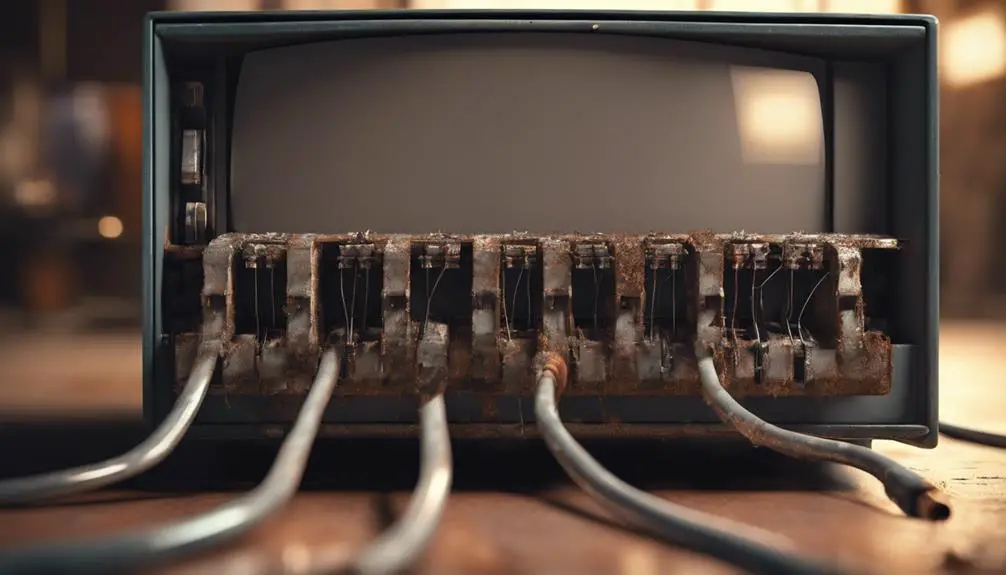Yes, a cable TV splitter can definitely go bad over time. You might notice poor picture quality, loss of channels, or frequent buffering, indicating a problem. Factors like physical damage, corrosion, or overloading can lead to failure. Environmental elements like humidity and temperature changes can also impact its performance. If your splitter is old or incompatible with new services, it may need replacing. Regularly testing it can help catch issues early. Keeping an eye out for these signs guarantees a better viewing experience. If you're curious about troubleshooting tips, there's more you can discover to keep everything running smoothly.
Understanding Cable TV Splitters
When you want to connect multiple devices to a single cable TV signal, a cable TV splitter can be a handy solution. It allows you to distribute that signal efficiently, giving you the freedom to enjoy your favorite shows on different screens without hassle. Fundamentally, a splitter takes one incoming signal and divides it into two or more outputs.
You can easily connect your TV, gaming console, or streaming device, all while maintaining a strong signal. However, it's vital to choose a high-quality splitter to minimize signal loss, ensuring you get the best viewing experience possible. With the right cable TV splitter, you can maximize your entertainment options and enjoy your space without the need for complicated wiring or multiple subscriptions.
Signs of a Malfunctioning Splitter
Recognizing the signs of a malfunctioning splitter is important to guarantee you're getting the best possible signal for your devices. If you notice any of the following issues, it might be time to evaluate a replacement:
- Poor Picture Quality: You're seeing pixelation or distortion on your screen.
- Loss of Channels: Certain channels are missing or unavailable, which used to work fine.
- Weak Signal Strength: Your signal meter shows low readings, indicating interference.
- Intermittent Connectivity: Your devices frequently lose connection or experience buffering.
When these signs crop up, don't ignore them. A faulty splitter can hinder your viewing experience, and you deserve uninterrupted freedom to enjoy your favorite content. Keep an eye out for these issues!
Common Causes of Splitter Failure
Several factors can contribute to splitter failure, impacting your cable signal quality and overall viewing experience. One common cause is physical damage; if a splitter gets dropped or knocked around, its internal components can become misaligned. Corrosion is another issue, especially if moisture seeps in, leading to rust that disrupts connections. Poor-quality splitters can also fail prematurely due to inferior materials or design flaws. Additionally, overloading a splitter by connecting too many devices can strain its capacity, causing signal degradation. Finally, electromagnetic interference from nearby electronic devices can degrade performance over time. By understanding these causes, you can take proactive steps to maintain your splitter and guarantee uninterrupted cable service.
Impact of Environmental Factors
Environmental factors, such as humidity and temperature fluctuations, can greatly affect the performance and longevity of cable TV splitters. You might not realize it, but these elements can introduce issues that limit your viewing experience. Here are some key factors to take into account:
- Humidity: Excess moisture can lead to corrosion, damaging the internal components of the splitter.
- Temperature: Extreme heat or cold can cause materials to expand or contract, affecting connections.
- Dust and Dirt: Particles can accumulate and obstruct connections, leading to signal loss.
- UV Exposure: Direct sunlight can degrade plastic casings, increasing vulnerability to damage.
Being aware of these factors can help you maintain your splitter and guarantee it delivers the quality you expect.
Testing Your Cable TV Splitter
To guarantee your cable TV splitter is functioning properly, it's important to regularly test its performance, especially after considering how environmental factors might have impacted its condition. Start by disconnecting the splitter and inspecting it for any visible damage. Then, reconnect the splitter and check each output with a signal meter or a TV. Make sure to compare the signal strength from the wall input and the outputs. If you notice significant drops in signal quality or if certain outputs don't work at all, it's a sign that something's off. Regular testing helps you maintain peak performance, ensuring you can enjoy your favorite shows without interruptions. Remember, staying proactive about testing can save you from future headaches!
When to Replace Your Splitter
Knowing when to replace your cable TV splitter can save you from frustrating signal issues and guarantee a smooth viewing experience. Here are some signs it's time to make that change:
- Weak Signal Strength: If channels are pixelating or dropping out consistently, your splitter might be to blame.
- Physical Damage: Cracks, frayed cables, or corrosion are clear indicators that your splitter's integrity is compromised.
- Old Age: If your splitter's been in service for several years, it may not perform as well as it used to.
- Incompatibility: Upgrading your cable service may require a new splitter designed for higher frequencies.

